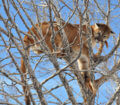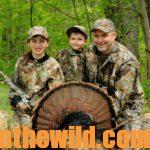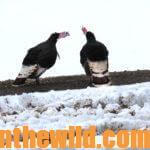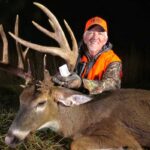Editor’s Note: With most game seasons closed across the U.S., except for hunting predators, I was very interested to talk with Lynn Worwood of Nephi, Utah, a Mossy Oak Pro (www.mossyoak.com) who hunts mountain lions. A very avid hunter of all species, especially turkeys, Worwood and his friends have fun hunting mountain lions from October until June each year. Other hunters chase predators year-round.
 I always have been interested in photography. I got bit by the photography bug when I was a kid. I always have carried a camera with me when I go hunting. I like taking pictures of wildlife, and I especially like photographing mountain lions because most people never have seen a mountain lion. Mountain lions are very secretive. They can hide really well, and they try to avoid people.
I always have been interested in photography. I got bit by the photography bug when I was a kid. I always have carried a camera with me when I go hunting. I like taking pictures of wildlife, and I especially like photographing mountain lions because most people never have seen a mountain lion. Mountain lions are very secretive. They can hide really well, and they try to avoid people.
On one hunt, I had to go down a ravine and walk under a log lying over the ravine. When I got on top of the ditch, one of my dogs came in and treed a cat that had been standing on that log that I just had walked under. I shoot a Nikon D5000 (www.nikon.com) digital camera, and I use a Nikon 70-300mm lens. I carry it in a backpack, until I reach the tree where the dogs have a lion bayed. Back when I was using a film camera, I’d usually shoot 20 to 30 photos of each cat we treed. However, today with my digital camera I shoot 50 or more to make sure I can get at least one good picture. One of the best pictures I ever made I shot with my film camera. We had treed a really big, huge, Tom lion, and he was in the top of a cedar tree. I was able to climb up the side of the mountain, so that I was level on the same plain as the cat. I was probably about 20 yards from the cat, and he was snarling and growling. I got some great pictures.
 I never will forget one hunt I went on with my wife’s cousin. About 18 inches of snow had fallen the night before we went hunting. We were walking up a road, and my wife’s cousin said, “I can’t really tell if this a lion track or not, but it looks like it might be. There’s so much snow in the track it’s hard to tell.” I told him, “Let’s put a couple of dogs on that track and see what they say about it.” I turned one of my dogs loose, and he turned another dog loose. I was reaching for the third dog when I looked back at the first two dogs, and they had jumped the lion out of the ditch right beside the road. The lion then quickly went up a tree. That was one of the shortest races I guess we ever had.
I never will forget one hunt I went on with my wife’s cousin. About 18 inches of snow had fallen the night before we went hunting. We were walking up a road, and my wife’s cousin said, “I can’t really tell if this a lion track or not, but it looks like it might be. There’s so much snow in the track it’s hard to tell.” I told him, “Let’s put a couple of dogs on that track and see what they say about it.” I turned one of my dogs loose, and he turned another dog loose. I was reaching for the third dog when I looked back at the first two dogs, and they had jumped the lion out of the ditch right beside the road. The lion then quickly went up a tree. That was one of the shortest races I guess we ever had.
I was hunting with my son, Mike, and he had dogs, and I had dogs. We had hunted hard and located a couple of cats. We were hunting with a friend of mine who had dogs also, and he said, “Let’s go over to a place I know of and see if we can find a cat big enough for Mike to take.” The dogs went up the side of a mountain and stayed on one particular ledge for a long time, which often meant a lion had spent a lot of time in that area. Finally, four or five of the dogs took off and ran about a mile from where we were. There were five dogs at the tree, but my old dog Bullet wasn’t there. Mike said, “I wonder where Bullet is. He should be here.” I replied, “I think Bullet is running a different lion.” I took my GPS tracker out of my pocket, and I could just barely pick up a signal from Bullet’s collar. Bullet was 1-1/2-miles away from where the other dogs were treeing. Bullet had another lion up a tree, and he was the only dog on the tree. A cat was standing in the top of a cedar tree with a blue sky behind him, and that was probably the biggest cat we ever caught in the last few years. He weighed close to 200 pounds.
 To learn more about hunting and fishing, check out John E. Phillips’ print, Kindle and audiobooks at johninthewild.com/books.
To learn more about hunting and fishing, check out John E. Phillips’ print, Kindle and audiobooks at johninthewild.com/books.









